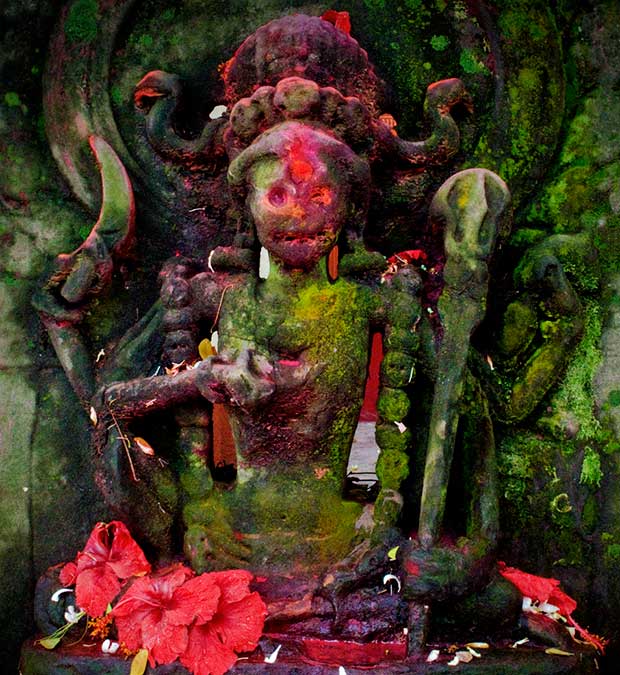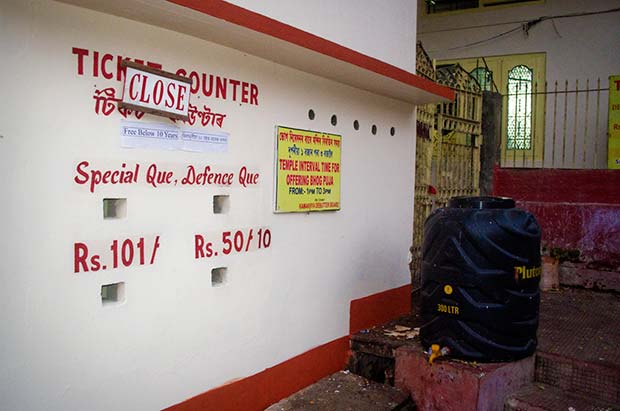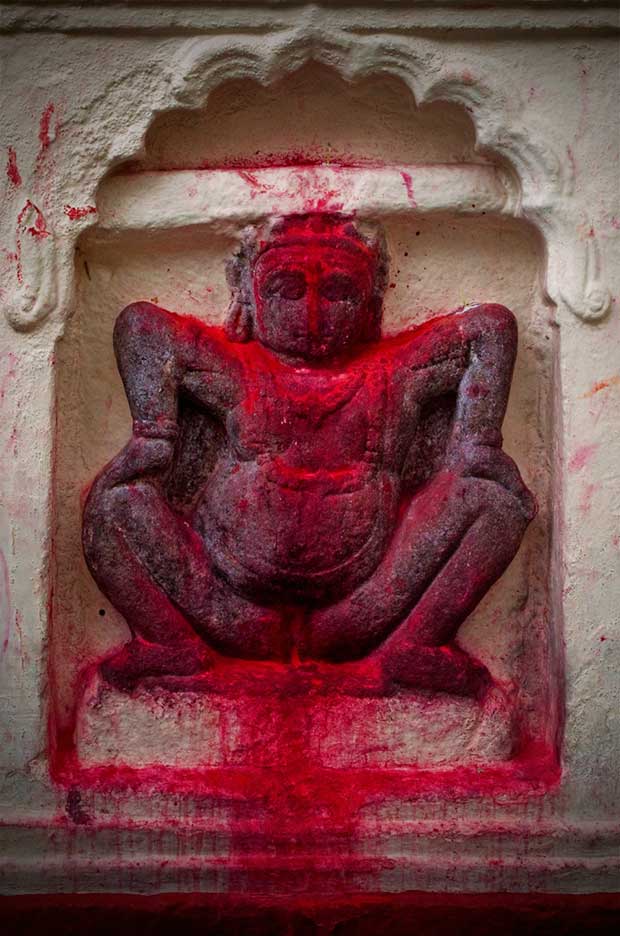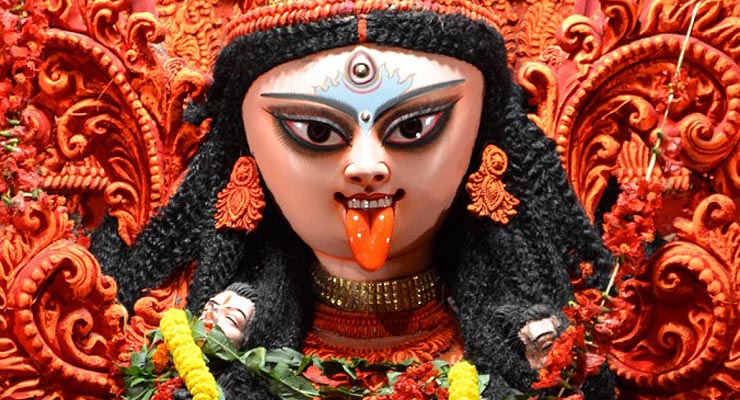
Beautiful and harrowing encounters with Kali, the Supreme Goddess of India, while traveling among the temples and spiritual mendicants of India
A narrow, unpaved road beginning near the main temple complex guides you along a winding path flanked on opposite sides with a motley arrangement of grave markers. As you approach the main entrance of the cremation ground, a small roadside temple presents itself. The phrase “JAY MA SMASHANA KALI” (Victory to Mother Kali of the Cremation Ground) is written above its doorway in bright red Bengali script. Housed within this shrine, a murti (sacred image facilitating divine communion) of Kali depicts her standing upon her husband—Lord Siva—in characteristic pose, brandishing a sword and holding a severed head with her left hand while her right hands give the mudras (symbolic hand gestures) of abhaya (fear not) and varada (conferring boons).
Although essentially depicting the dark mother goddess Kali in her popular form, a few macabre embellishments have been added here to emphasize the particularly fierce nature of her smashana (cremation ground) aspect. Wavy red lines, flowing from the corners of her mouth around her cheeks and down her neck, have been painted to represent oozing blood. On Kali’s left and right sides, two semi-nude female shaktis (human embodiments of feminine force) gaze upward toward her as they dance, both of them smeared with gore and feasting on human flesh.
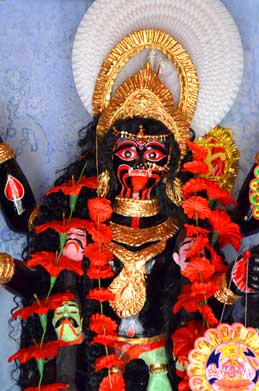
Bakreshwar’s sacred burning ground is separated from the surrounding area by a border of tombstones and a small river running along its side. Cremation here differs from other cremations I have observed in that a network of connected trenches is employed to contain the improvised wooden pyres. The resultant fire, burning at ground level, is thus easily managed by the Dom, who use bamboo poles to manipulate the wood and break the body down as it is slowly incinerated. Pieces of wood that haven’t burned away are removed, put aside, and later incorporated into fresh pyres.
RELATED: 7 Hindu Gods That Will Blow Your Mind
To be cremated at Bakreshwar is considered particularly auspicious, so it follows that this burning ground is a highly active one. Dead bodies routinely arrive—not just from the local community, but also from various locations throughout West Bengal and even as far away as the neighboring states of Bihar and Jharkhand. During my daily visits, I often witnessed up to five pyres burning at the same time. The soil here is permeated with ash, imparting it with an overall gray cast. Where the river runs directly alongside the cremation ground, its water is almost black.
Much of my time at Bakreshwar was spent interacting with the local Dom, who seemed just as eager to hear stories of my life in America as I was to learn about their unique occupation. The cordial hospitality of the Dom contrasted with the immediate gloomy environment. While seated amidst blazing, crackling funeral pyres, I found myself regularly being offered tea and snacks. Together we would also frequently indulge in the more ill-advised pleasures of smoking bidis (tobacco-leaf wrapped cigarettes) and ganja, as well as quaffing copious amounts of bangla—a local rice-based moonshine. I have many fond memories of the Bakreshwar smashana; despite it being a place of death, I mostly recall the friends I made, along with the laughter and good times we shared.
Early one morning, I visited the smashana and encountered a small group of Dom gathered together near a single burning pyre. One of the men greeted me and was excited to find I could converse in Bengali. He brushed off a tombstone and offered me a seat beside him to talk. A chai wallah, standing nearby with a kettle in his hand, was immediately called over. My new friend then pointed at the funeral pyre (with a clearly recognizable human corpse burning on top of it), said a few words, and the tea pot was placed directly into the fire. As we chatted over the warm cup of chai, I thought of how bizarre this entire scenario would seem to most folks I know back home.
Kali reminds us that death is an inescapable aspect of life, that people generally confront only when forced to do so. For most of us, it remains safely hidden away until it ultimately appears—seemingly out of nowhere—to rear its ugly head before once again returning to the shadows. For the Dom, however, there is nothing at all unusual or shocking about the atmosphere of the cremation ground. Dealing directly with the grim reality of death is just another day on the job.
When reflecting back on the time I spent at Bakreshwar, I will always remember Korno, a twenty-one year old Dom boy who I became close friends with. Over the course of my stay in India we forged a bond that I suspect will last the rest of my days. It was because of Korno that I was able to experience as much of an inside view of Dom life as could be hoped for during a brief stay. A tantalizing angle for pursuing further research into the mysteries surrounding Kali crystallized during an afternoon ganja session we shared near the cremation ground.

On this day I visited the smashana and found it surprisingly empty, a rather infrequent occurrence, allowing the Dom to enjoy some respite from their work. While wandering about, I chanced upon a group of Dom sitting with a Tantrik (practitioner of magical arts) and was asked to join them. As a freshly-packed chillam (cylindrical clay pipe) was passed around, we were discussing more mundane matters when Korno asked me if everyone in the USA followed Christian dharma (ancient word referring to universal order, used here in the common sense as “religion”). I explained that while the majority of Americans are Christian, there is a mixture of spiritual beliefs there, reflecting the diverse population. He then asked if I was a Jishu bhakta (literally “Jesus devotee”) as well. When I responded to this question by stating that I am a bhakta of Kali, the group became visibly elated. Waving his hand in a circle, Korno enthusiastically proclaimed that everyone in the group was also a bhakta of Kali. He then added with a friendly smile, “Kali is one of us, she is a chandala!” This word “chandala” comes to us from Sanskrit, originally as a designation for lower caste people whose occupation is the disposal of corpses. In modern times, it is commonly used as a pejorative to slander people as low, filthy or generally despised.
In all of my encounters with the Dom, I have invariably found them to be devotees of the archetypal dark mother goddess Kali, or the closely related Ma Tara. As a liminal deity associated with the social periphery and cremation ground, Kali would seem a fitting patron for the Dom—members of a stigmatized caste traditionally considered “untouchable” by mainstream society. However, it appears counterintuitive that within a patriarchal and caste-oriented social system, the image of a low-caste female would be widely venerated as the ideal anthropomorphic representation of the cosmic matriarch. Kali the mother, as we know her today, is a multifaceted deity who undoubtedly developed through the synthesis of myriad indigenous goddesses whose roots reach back into prehistory.
RELATED: Here’s an Awesome Map of the Gods & Goddesses of Hinduism
It is not unreasonable to assume that the modern Dom descend from a tribal group who were subjugated at some point in the distant past. Relegated to the lowest rank of society, such a vanquished people would naturally take their patron goddess Kali with them as they moved about, engaging in occupations determined by their caste. Although the origins of Kali may forever remain obscured by an impenetrable veil of mystery, I believe that a key to shedding a modicum of light upon her shadowy evolution lies within the seemingly parallel saga of the Dom. My own experiences have consistently affirmed that a profound connection exists between the black mother and this stigmatized caste that venerates Kali. It is an intriguing relationship that I feel obliged to investigate and make the focal point of future research. Through photography, field recording, and writing, I hope to share some of my discoveries and revelations as the outward, tangible reflection of an essentially internal, spiritual journey while I dedicate my life to exploring the Kali mythos—wherever she may guide me.
Drinking From Ma Kamakhya’s Fountain of Desire: Encountering Ma Kamakhya, a Tantric Hindu Goddess Closely Associated With Kali Ma
After observing the massive crowds this temple can attract, I decided to do the heroic thing and pull an all-nighter, figuring that an early arrival would insure a quick darshan (Sanskrit word, literally “seeing”) of Ma Kamakhya. This is an event which I have looked forward to for over a decade, and my anticipatory excitement had only been building up since I arrived in Assam. I am now on the sixth day of my stay, and I have located and paid my respects at each of the seven other mahavidya mandirs (wisdom goddess temples) that are found on Nilachala Hill. At this point, it only made sense to do what I came here to do. So I stayed up throughout the night, combing through the photos and field recordings I’ve collected, while letting the rising sense of expectation work its vitalizing magic. At 5 a.m. I stopped whatever I was doing, got ready, then rushed out and bought the nicest jaba mala (hibiscus garland) I could find before heading straight to the mandir. However, instead of a swift meeting with “She Whose Form is Desire,” I ended up being dragged kicking and screaming through the Hell of Being Trapped in the General Queue.
Alright, that was an exaggeration. I wasn’t exactly kicking and screaming, because there simply isn’t enough room to do anything like that. Ma Kamakhya has such a huge fan-base that an unattractive cage system has been inconveniently installed at the temple in order to keep her groupies in line. Around 6:00 a.m., I eagerly entered this fenced-in Tunnel of Doom on its left side, a.k.a. the general queue side, and found myself trapped with an equally dismayed group of thousands for the next 5 1/2 hours. Not that I’ve ever been arrested or anything, but it reminded me a lot of what it felt like being inside Chicago’s Cook County Jail. Only the crazy love I have for Ma could motivate me to remain still in such conditions for that long. Well, either that or the steel gates that kept me from leaving. After the first hour of this endurance test, staying up all night began to seem like a really bad idea. I struggled as best I could to focus my mind on what was about to take place as I watched the fresh jaba mala I had purchased earlier slowly wither thanks to the oppressive heat.
I cannot deny that this 5 1/2 hour ordeal of the queue had me feeling like I was like being tortured at times. Anything for Ma, but this was seriously an act of tapasya (spiritual austerity) that I would rather never have to deal with. In spite of not sleeping and being literally caged in, the experience of Ma’s darshan was something I was immensely grateful for–so I had to be tough. Often I found myself to be the passive observer while a litany of goddess names, mantras, and prayers swirled together in my head as my sleep-deprived mind turned everything I tried to focus on into mush. Kali who is in everything and at every time I love, is one line I still remember. As much as I disliked the wait, I had to admit to myself that this naturally altered state of consciousness seemed strangely appropriate–and it certainly intensified everything was about to take place.
Because this line from the queue normally blocks any view of the temple’s southern outer wall, I could now see that there are numerous worn and weathered statues sporadically embedded throughout it. I’m not sure if it was the lack of sleep or quickly approaching heat exhaustion, but my mind began to wander through strange territories as I gazed at these unfamiliar icons and thought about the history of this place. Multi-armed figures holding aloft weapons and severed heads, fearsome looking yogis, and dancing female forms guided me through the forests of Nilachala Hill, back through time to the temple as it once was–when the spirituality here was raw, coming directly from the vulva of the earth. This place is beyond ancient, I thought to myself, as Aztec-like imagery flooded my dream scene.
Before all the gates, locks, and steel bars, and even before the much older shikhara (domed cap above the sanctum sanctorum), sculptures, and ruins one finds scattered about, this place was the sacred site of The Mother Goddess. Its roots run deep, going back way before any history of this area was committed to writing. Kamakhya was once a center of tribal (the Khasi to be exact) worship, and they too venerated the Mother at this very spot–worshipping her divine vagina in the earthly form of a black stone. That might seem a bit strange, but this is no ordinary rock. Not only does its shape physically resemble a vulva (it definitely does), but water constantly oozes out of it. Even more peculiar is the yearly phenomenon when this water turns deep red for a few days: the earth literally menstruates at Kamakhya. A large festival at the temple, called Ambuvachi Mela, celebrates this sacred period of the Divine Mother’s menstruation.
Some of the indigenous practices still persist, albeit in slightly altered form. For example, at the western-most end of the temple complex is a large pavilion where animals such as water buffalo, ducks, pigeons, and countless goats, are regularly beheaded as offerings to the Goddess. A sense of awareness washed over me, bringing with it a realization: The Khasi sacrificed a lot of people here. And then the last gate opened up. Cling-clang.
(Later on, I found out why the general queue line is so painfully sluggish. Apparently, there’s a ticket system in place at the Kamakhya Mandir. For the least amount of hassle, 501—the extra rupee is for good luck—rupees will buy you a direct entry into the smaller mandir attached to the main temple with a waiting time of no more than half an hour tops. A 101 rupee ticket will cut your wait time down to two hours or much less depending on the crowd. I had heard rave reviews about this ticket counter, but whenever I searched for it, all I could ever find was a sign painted on a wall. Eventually, I had to ask a security guard to directly point it out for me. He seemed rather frustrated because I kept asking him where it was every twenty minutes. Although everyone here seems to think it’s location is pretty obvious, you might understand why I had some trouble finding it if you by take a look at the photo of this ticket counter which I have appended below for the purpose of easy identification.)
Once that gate finally opened, I couldn’t wait to get inside and offer my jaba mala to Ma Kamakhya, along with a life time of devotion. I had no idea what to expect, and entering the Kamakhya Mandir proved to be an otherworldly experience. Much like some of the other mandirs on Nilachala Hill that I had previously visited, the Kamakhya Temple requires that you descend steps into a space resembling a cave. Not only is it dark inside, but the walls and supporting pillars are made of black rock, enhancing the feeling of spaciousness. Despite being an enclosed area, it somehow feels vast and open. Once again, there were the mysterious carved stone figures placed in hollows throughout the walls–divine and human figures whose identity and purpose remain unknown to me. As I flowed with the mass of bodies that slowly meandered through this cavernous environment, guided only by sparse lighting and the shouts of temple priests, a delightfully disorienting effect took hold of my consciousness. The seemingly endless river of devotees were being led along the outer wall in a clockwise motion, a path which passed around a centrally-placed deity.
This deity was an anthropomorphic representation in the form of a small cast metal statue. She is housed in an ornate silver shrine decorated with peacock and floral motifs. A purohit (temple priest) instructed me to give her pranam (salutation). As I did so, I asked him what the name of this goddess was. He responded with a confused look and told me that it was Kamakhya. I looked about and saw a few paintings of the goddess in her six-headed human form hanging in different places. Since this shrine is the only area inside the temple which is visible from the outside, my guess is that it is a stand-in Kamakhya image for more casual public worship. Her cast image, however, is barely discernible as it is practically buried underneath a mountain of flowers. A silver crown was placed upon her head and a few silver umbrellas dangled from a canopy above. Now that I had a closer look at something which I had already prayed to numerous times, I could see that the entire display is, in actuality, an ornate miniature silver temple. Ma Kamakhya’s public image is a beautiful testament, but there was little time for observation as the crowd was eagerly pushing me forward: I was being hastened into the sanctum sanctorum containing Her original form.
Crossing the arched threshold brings you to a dozen or so steps which lead down into a large circular black chamber which is thick with incense smoke. I looked around and saw shadowy stone figures staring at me, their forms completely indistinguishable in the darkness. The only source of light inside the garbhagriha (womb chamber) was coming from a few small oil lamps which were burning here and there. Again I was shoved forward, and looked down to see a priest seated beside an area which was illuminated by several of these lamps–it was Ma Kamakhya. Her yoni (sacred vagina) is big, but almost completely covered by decorative sari cloth. Flowers were everywhere. There was constant shoving from the relentless crowd; I realized there was no time to lose, so I quickly but gently placed my jaba mala upon Her curved surface before kneeling on the ground and bowing my head.“Give Mother your hand!” shouted the priest, pointing toward an exposed area at the base. Here, Ma’s pudendum was bare for all to see: a naturally cleft black stone, painted red with sindoor (vermillion) paste. It contained a small pool of water. Without hesitation I reached into Kamakhya’s yoni, the water coming up to my wrist. Placing my submerged palm against the stone, I mentally offered my will to the love of the Mother Goddess before cupping my hand and taking as much water as I could to my mouth and gulping it all down. For this, I received a rather funny wide-eyed look from the priest who was still chuckling as he waved the next person in.
RELATED: God, Annihilator: My Meeting With Kal Bhairav, the Wrathful Form of Shiva
Unlike most Hindu temples in general, darshan of Ma Kamkhya is based upon the sense of touch rather than sight. Once I was again moving along with the herd of devotees, I watched others interacting with Kamakhya. All of them were simply touching the water and then caressing their head! I wondered how many hands had been inside that water, and giggled to myself as I realized that drinking it is probably not the most sanitary thing to do. My internal voice joked: Oh well, how could you not do that?! It’s the Mother Goddess’ sacred vaginal fluid, so there is no way you’re gonna get sick. If anything you’ll end up with God powers.
After offering pranam to the yonis of Lakshmi and Saraswati (or Kamala and Matangi if you’re Tantrik), which are also located in the inner sanctum, I passed a few more stone statues (what are these things anyway?) as I headed toward the exit door. A younger Brahmin friend I bumped into along the way informed me that it is customary to circumambulate the temple three times in a clockwise fashion after the completion of puja (formal worship). This was news to me, but I thought of it as nice opportunity to formally end the experience of darshan with a spontaneous closing ritual. The sun seemed incredibly bright as I stepped back outside and headed for the front entrance–I had been inside the temple for more than 30 minutes. Facing the temple’s front door, I clasped my hands together and recalled a bit of word salad from the queue delirium I had suffered a few hours earlier. I then laid flat on the ground and extended my arms, touching the thumbs and index fingers of my hands to form a triangle which was pointed toward the yoni of Ma Kamakhya. Kali who is in everything and at every time I love. My eyes teared up when I realized what I was doing. It has been more than 15 years since I became a devotee of Kali Ma and here I was offering my love to Her at the Mother of all Mother Goddess temples. My first darshan of Kamakhya could not have been more perfect. I repeated this act of mental recitation coupled with physical prostration two more times, thanked Ma for bringing me here, and then went to go get myself some breakfast.
For more of William Clark’s travelogues and writing on Kali, check out his website. For the secrets of Hindu Tantra themselves, check out Ultraculture Journal.
